ACS Fall 2024
Join Pacific Northwest National Laboratory (PNNL) at the annual fall conference hosted by the American Chemical Society (ACS), where scientists from PNNL will be presenting the latest research in chemistry and materials
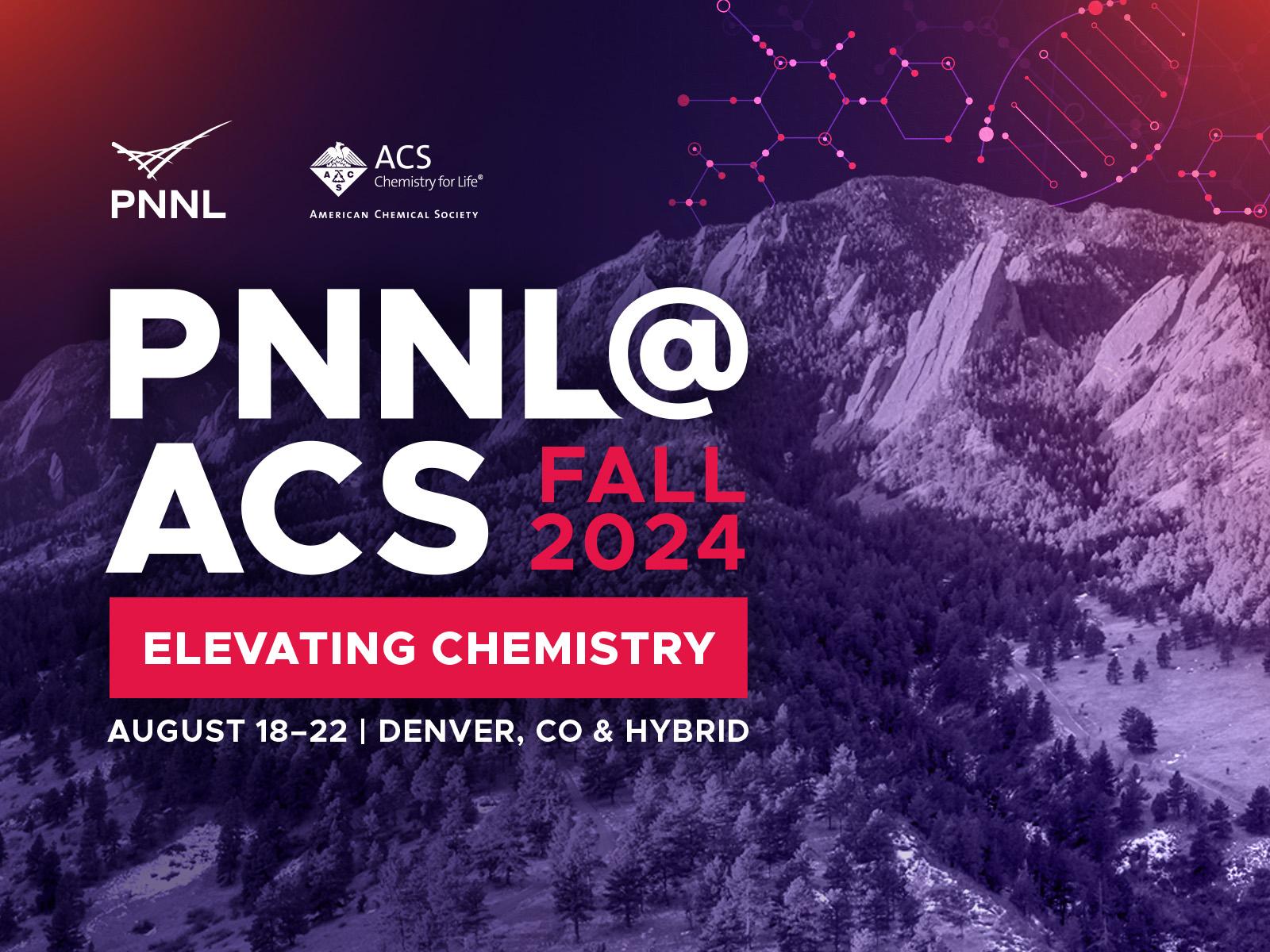
Denver, Colorado, and Hybrid
Elevating Chemistry, the theme of the American Chemical Society (ACS) Fall 2024 conference, features a mix of hybrid, in-person, and live virtual sessions, along with keynote events, expo hours, and poster events.
If you’re a chemist and interested in joining our team of researchers, take a look at our current openings:
Many researchers from PNNL will be participating in this year's conference. View the list of some ACS Fall keynote events below.
Key Sessions and Symposia organized by PNNL
Sunday, August 18
Catalysis for Renewable Fuels & Products: Scalable Processes for Biomass & Waste Carbon Valorization
Organizer: Vanessa Dagle
Advanced In-Situ Imaging Methods for Colloidal Chemistry: Probing Interaction & Dynamics at the Nanoscale
Organizer: Dongsheng Li
Monday, August 19
Addressing the Complexity of Correlated Quantum Many-Body Problems by Embedding & Downfolding
Organizer: Karol Kowalski
Electrocatalysis & Sustainable Chemistry Based on Metal Hydrides: Symposium in honor of Morris Bullock (PNNL emeritus)
Organizers: Aaron Appel and Ba Tran
Tuesday, August 20
Advanced In-Situ Imaging Methods for Colloidal Chemistry: Probing Interaction & Dynamics at the Nanoscale
Organizer: Dongsheng Li
Addressing the Complexity of Correlated Quantum Many-Body Problems by Embedding & Downfolding
Organizer: Karol Kowalski
The Role of Mineral-Water Interfaces in Carbon Mineralization & Critical Mineral Recovery
Organizers: Emily Nienhuis-Marcial
Advances in CO2 Capture & Conversion: Mineralization, Direct Ocean Capture & Modeling
Organizers: David Heldebrant and Deepika Malhotra
Wednesday, August 21
Addressing the Complexity of Correlated Quantum Many-Body Problems by Embedding & Downfolding
Organizer: Karol Kowalski
Advances in CO2 Capture & Conversion: Mineralization, Direct Ocean Capture & Modeling
Organizers: David Heldebrant and Deepika Malhotra
Mineral Crystallization, Aggregation & Dissolution
Organizer: Xin Zhang
Thursday, August 22
Advanced In-Situ Imaging Methods for Colloidal Chemistry: Probing Interaction & Dynamics at the Nanoscale
Organizer: Dongsheng Li
Mineral Crystallization, Aggregation & Dissolution
Organizer: Xin Zhan
Selected PNNL Presentations
Sunday, August 18
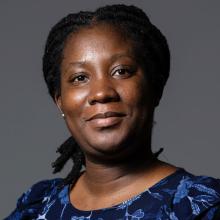
Surface Hydroxylation of Magnesium Oxide and Forsterite
9:25–9:45 a.m. MT | Room 113
Presented by: Mavis Boamah
Summary: Surface hydroxylation of mineral oxides plays essential roles in geochemistry and technological/industrial applications. Understanding the vibrational structure of hydroxyl groups present at aqueous interfaces of minerals will help us gain insight into their reactivity in controlling and predicting interfacial chemistry...See more.
Monday, August 19
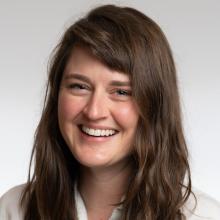
Chemical Composition Drives Carbon, Nitrogen, and Phosphorus Mobilization across Burn Severities
8:05–8:30 a.m. MT | Room 108
Presented by: Allison Myers-Pigg
Summary: Wildfires significantly alter terrestrial carbon (C), nitrogen (N), and phosphorus (P) pools through the incomplete combustion of biomass. We postulate that the environmental fate of pyrogenic organic matter is linked to shifts in the chemical composition of C, N, and P that occur across burn severities and with different vegetation types...See more.
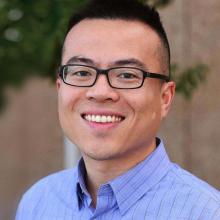
Quantum Embedding in Excitation Manifold
8:35–9:05 a.m. MT | Room 704
Presented by: Bo Peng
Summary: This talk introduces a coupled-cluster Green's function (CCGF) embedding approach that integrates conventional CCGF theory with the sub-system embedding sub-algebras coupled cluster (SES-CC) formalism. This integration primarily focuses on delineating the characteristics of the sub-system and the corresponding segments of the Green's function, explicitly defined by active orbitals...See more.
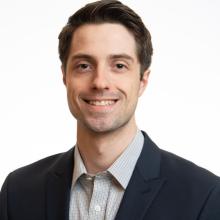
Effects of Geometry at Cu(I) Complexes on Hydrogen Activation and Beta-Elimination Reactions
8:55–9:20 a.m. MT | Mile High Ballroom 2A
Presented by: Evan Patrick
Summary: Enabling the reactivity of metal complexes by controlling their geometries is a hallmark of organometallic chemistry. d10 Cu(I) complexes can adopt a variety of geometries, in which linear, trigonal planar, and tetrahedral complexes are common...See more.

Toward the Control of Metal Hydrides Reactivity for CO2 Reduction
9:35–10:00 a.m. MT | Mile High Ballroom 2A
Presented by: Simone Raugei
Summary: Metal hydrides can be effectively employed in thermo- and electrocatalytic processes for renewable energy storage and production. To design catalytic processes with enhanced performance, several electronic structural factors that determine hydride donorability can be tuned...See more.
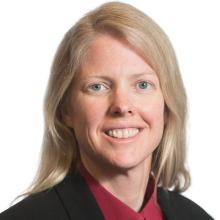
How Does the Protein Scaffold of an Artificial Enzyme Contribute to Catalysis for Hydrogen and CO2 Chemistry?
10:00–10:25 a.m. MT | Mile High Ballroom 2A
Presented by: Wendy Shaw
Summary: Artificial enzymes can be a tool for the detailed study and understanding of design principles of enzymes for ultimate translation to synthetic catalysts. Using a robust protein scaffold, lactococcal multidrug resistance regulator, LmrR, we have provided structured secondary and outer coordination spheres around molecular complexes, [M(PNglyP)2]...See more.
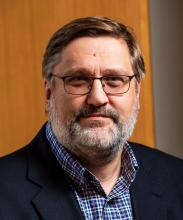
Coupled Cluster Downfolding Formalisms for Simulating Many-Body Systems
10:25–10:55 a.m. MT | Room 704
Presented by: Karol Kowalski
Summary: We focus on quantum flow (QFlow) approaches that can sample large sub-spaces of the Hilbert space through coupled eigenvalue problems in reduced dimensionality active spaces. Our QFlow algorithms are designed to significantly reduce the dimensionality of the many-body problem and establish embedding methods that capture the sparsity of quantum systems...See more.
Effects of Geometry at Cu(I) Complexes on Hydrogen Activation and Beta-Elimination Reactions
2:00–2:25 p.m. MT | Mile High Ballroom 2A
Presented by: Evan Patrick, Jeremy Erickson, Morris Bullock, Ba Tran
Summary: Enabling the reactivity of metal complexes by controlling their geometries is a hallmark of organometallic chemistry. d10 Cu(I) complexes can adopt a variety of geometries, in which linear, trigonal planar, and tetrahedral complexes are common...See more.

Spatio-Temporal Impacts of Wildfire on Organic Matter Chemistry Through a Stream Network is Related to Watershed Properties and Burn Severity
4:45–5:10 p.m. MT | Room 108
Presented by: Alan Roebuck
Summary: Wildfires can be major ecosystem disturbances that have cascading impacts on downstream water quality and hydrobiogeochemical processes. We focused efforts in the McKenzie River Sub-Basin near Eugene, Oregon, USA, where 17% of the watershed burned in 2020 during the Holiday Farm Fire...See more.
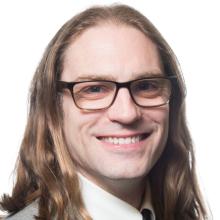
Development and Application of a Systematic and Extensible Force Field for Peptoids in Solution (STEPs-SOL)
5:00–5:20 p.m. MT | Hall D-Room 1
Presented by: Marcel Baer
Summary: Peptoids are a class of biomimetic polymers that have attracted significant attention due to their accessible synthesis and enzymatic and thermal stability relative to their naturally occurring counterparts. While these polymers promise more robust functional materials, they present a new problem for the computational prediction of structure for material design...See more.
Tuesday, August 20
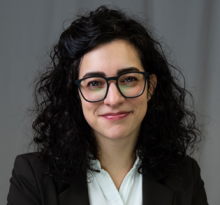
Atomically-Defined Metal Carbon Nitride Electrocatalysts for Long-Duration Energy Storage
8:50–9:10 a.m. MT | Room 407
Presented by: Krista Kulesa
Abstract: Meeting decarbonization goals requires affordable, secure renewable energy sources with high energy density and long shelf-life. While hydrogen is an excellent source of long-term carbon-neutral energy, H2 must be compressed to high pressures or liquefied at extreme temperatures...See more.
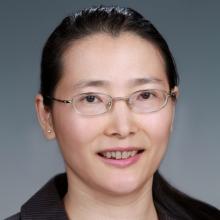
Understanding and Controlling Crystal Growth and Assembly via In Situ Techniques
2:00–2:30 p.m. MT | Governor's Square 17 (Sheraton Denver Downtown Hotel)
Presented by: Dongsheng Li
Summary: Materials’ properties are tied to their structures at micro-, nano-, and atomic scales. Understanding the fundamental mechanisms of crystal growth and factors that control them enables us to design materials with tailored properties. In this work, we study mechanisms of crystal growth via particle attachment and assembly by integrating in-situ techniques with theoretical simulations...See more.
Tracing Carbonate Mineralization in Mafic-Ultramafic Rocks with Thermogravimetric Analysis-Mass Spectrometry
2:25–2:45 p.m. MT | Room 113
Presented by: Madeline Bartels
Summary: To expand the monitoring, reporting, and verification capabilities of geologic carbon mineralization projects, we developed a thermogravimetric analysis−mass spectrometry (TGA−MS) methodology to quantify <100 ppm calcite in complex samples...See more.
Carbon Mineralization, Critical Mineral, and Olivine Resource Evaluation Pathways for Mafic-Ultramafic Assets
3:05–3:30 p.m. MT | Room 113
Presented by: Heath Stanfield
Summary: Locating and developing ideal sites for large scale capture and storage of carbon dioxide has become increasingly necessary due to increasing global emissions and warming. Mafic-ultramafic rocks present a unique geologic setting as they can trap injected CO2 in pore space, mineralize that CO2 to permanently store it as carbonate minerals, and simultaneously release critical minerals...See more.

Understanding Particle Aggregation-Based Crystallization Pathways by Using Advanced Transmission Electron Microscopy and X-ray Scattering Techniques
3:45–4:00 p.m. MT | Governor's Square 17 (Sheraton Denver Downtown Hotel)
Presented by: Xin Zhang
Summary: Particle aggregation, particularly through oriented attachment, is a multifaceted phenomenon crucial for understanding crystal growth mechanisms. Our research employs a combination of cutting-edge techniques and computational methods to unravel the intricacies of particle aggregation and its relationship to interfacial structure under varying conditions...See more.

Activity-Based Protein Profiling Strategies for Identifying Highly Sensitive Protein Targets of Organophosphate Pesticides
3:45–4:15 p.m. MT | Room 504
Presented by: Vivian Lin
Summary: Activity-based protein profiling (ABPP) is a chemoproteomic technique that enables protein target identification based on the target's specific mechanism of action. We have previously developed activity-based probes for discovery of proteins that bind to organophosphate pesticides to understand how these chemical exposures perturb various functions throughout the body...See more.
Wednesday, August 21
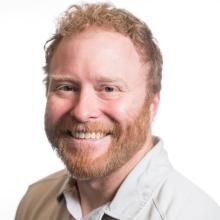
Direction-Specific Diffusion of CO2 Augmented by Polygonal Rifling in Chiral B-N Nanotubes
8:05–8:35 a.m. MT | Room 502
Presented by: David Heldebrant
Summary: Separating carbon dioxide from dilute gas streams remains challenging due to high costs and energy intensive sorbents. CO2 molecules move inside adsorbents or membranes via Brownian Motion, meaning their diffusion is non-directional...See more.
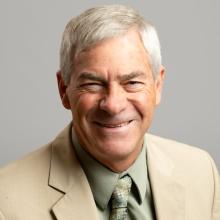
In Situ Look at Interfacially-Driven Mineralization
8:30–8:55 a.m. MT | Room 113
Presented by: Jim De Yoreo
Summary: Interfaces are ubiquitous in geochemical systems and play a critical role in mineralization reactions. This work presents examples from in situ transmission electron microscopy and atomic force microscopy studies of interfacial structure, nucleation, and particle assembly to elucidate the mechanisms by which interfaces direct these processes...See more.

Theoretical Study on the Role of Interfacial Dipolar Interactions in Directing Growth Pathways and Dimensionality of the Crystal
9:20–9:40 a.m. MT | Room 113
Presented by: Duo Song
Summary: Precise control over morphology and dimensionality during homogeneous and heterogeneous nucleation is critical for functional materials because atomic arrangement defines their electronic structure and properties. We showed that branching in ZnO nanocrystals is triggered by dipole accumulation along the slow growth direction in aqueous solution...See more.

Interfacial Drivers for the Formation of Hierarchical Architectures
10:15–10:40 a.m. MT | Room 113
Presented by: Maria Sushko
Summary: Crystallization often does not follow the monomer-by-monomer addition pathway described by classical nucleation theory. Instead, the initial steps may involve the formation of larger building blocks, such as crystalline or amorphous nanoparticles, droplets, clusters, complexes, or oligomers, that subsequently undergo assembly into a crystal...See more.
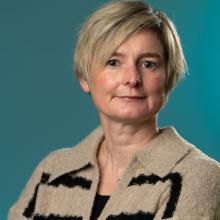
Metastable Intermediates Facilitate Aluminum Transformations in Concentrated Alkaline Electrolytes Representative of Radioactive Waste
11:30–11:55 a.m. MT | Room 113
Presented by: Carolyn Pearce
Summary: Retrieval and processing of legacy radioactive waste stored in underground tanks at the U.S. Department of Energy’s Hanford site is the focus of the Interfacial Dynamics in Radioactive Environments and Materials (IDREAM) Energy Frontier Research Center. We present a series of IDREAM studies using...See more.

Rare-Earth Adsorption, Incorporation and Precipitation Under Basic Solution Conditions
3:05–3:30 p.m. MT | Room 113
Presented by: Zheming Wang
Summary: Rare earth elements (REE) play increasingly critical roles in many industrial and technological applications, but their supply is becoming increasingly scarce. In this work, we explore the chemistry of i) REE adsorption and incorporation in aluminium hydroxide in basic solutions and ii) REE complexation and precipitation in bicarbonate and carbonate solutions...See more.

Effect of Trace Metal or Organic Matter Adsorption on Aluminum Mineral Dissolution in Caustic Solutions
3:40–4:05 p.m. MT | Room 113
Presented by: Xin Zhang
Summary: Understanding the dissolution of aluminum minerals such as gibbsite and boehmite is critical for the treatment of nuclear waste. Chromium(III)/organic matter (OM)-adsorbed boehmite/gibbsite has a much lower dissolution rate than pure boehmite/gibbsite...See more.
Molecular-Resolution Elucidation of Ice Defects Formed by Liquid Water Crystallization
5:00–5:15 p.m. MT | Room 710
Presented by: Jingshan Du
Summary: Despite the ubiquity of ice, defects formed by water crystallization have never been directly observed on the molecular scale. We report the stabilization and Ångstrom-resolution electron imaging of ice crystallized from liquid water. We show that ice is highly tolerant to nanoscale defects such as...See more.
Thursday, August 22

Self-Assembly at the Protein-Materials Interface
9:00–9:30 a.m. MT | Plaza Court 2 (Sheraton Denver Downtown Hotel)
Presented by: Jim De Yoreo
Summary: In their folded state, peptides and proteins can be viewed as colloidal particles with an atomically precise distribution of charged, hydrophobic, and reactive patches. Here we present the results of in situ atomic force microscopy studies of peptide and protein assembly on surfaces that illustrate the complex behavior of these systems...See more.

Modeling Multiphase Chemistry of Biomass Burning Phenols and Their Potential to Form Secondary Organic Aerosols
11:35 a.m.–12:00 p.m. MT | Room 103
Presented by: Manish Shrivastava
Summary: Phenols emitted from biomass burning contribute significantly to secondary organic aerosol (SOA) formation through the partitioning of semivolatile products formed from gas-phase chemistry and multiphase chemistry in aerosol liquid water and clouds. We developed novel box model formulations to investigate...See more.
For additional information on chemistry at PNNL, please visit our website.